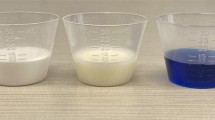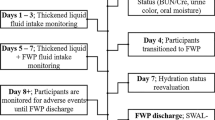Abstract
The purpose of this study was to examine the effects on a patient’s swallowing of diluting E-Z-EM’s Varibar® Thin liquid barium product (which is often used in videofluoroscopic swallow studies) to achieve a consistency closer to water. Forty patients who were 18 years and older participated in this study. Their varied medical diagnoses included stroke, pneumonia, TBI, and cancer as well as diagnoses not usually associated with dysphagia such as abdominal pain and rhabdomyolysis. To screen for aspiration, E-Z-EM’s Varibar Thin liquid was presented to patients to swallow as 2 cc, 5 cc, cup, and straw drinking trials. If no aspiration occurred, the patient was given the Varibar Thin liquid diluted by 50% using water (referred to as Ultrathin) to swallow in the same amounts. Then occurrence of aspiration with the Ultrathin liquid was compared to the occurrence of aspiration when the patient swallowed the Varibar Thin liquid. Fifty percent of patients aspirated on the Ultrathin liquid but not on the Varibar Thin liquid, across at least one of the test conditions. From these results we suggest that although E-Z-EM Varibar Thin liquid may have a low-viscosity range, it still may not be “thin enough” to identify all patients who aspirate or who are at risk for aspiration on thin liquids.
Similar content being viewed by others
References
National Dysphagia Diet Task Force. National Dysphagia Diet: Standardization for optimal care. Chicago, IL: American Dietetic Association; 2002.
Kuhlemeier KV, Palmer JB, Rosenberg D. Effect of liquid bolus consistency and delivery method on aspiration and pharyngeal retention in dysphagia patients. Dysphagia. 2001;16:119–22. doi:10.1007/s004550011003.
Raut VV, McKee GJ, Johnston BT. Effect of bolus consistency on swallowing - does altering consistency help? Eur Arch Otorhinolaryngol. 2001;258:49–53. doi:10.1007/s004050000301.
Dantas RO, Dodds WJ, Massey BT, Kern MK. The effect of high- vs. low-density barium preparations on the quantitative features of swallowing. AJR Am J Roentgenol. 1989;153:1191–5.
Dantas RO, Kern MK, Massey BT, Dodds WJ, Kahrilas PJ, Brasseur JG, et al. Effect of swallowed bolus variables on oral and pharyngeal phases of swallowing. Am J Physiol. 1990;258:G675–81.
Steele CM, Van Lieshout PH. Influence of bolus consistency on lingual behaviors in sequential swallowing. Dysphagia. 2004;19:192–206. doi:10.1007/s00455-004-0006-5.
Daniels SK, Schroeder MF, DeGeorge PC, Corey DM, Rosenbek JC. Effects of verbal cue on bolus flow during swallowing. Am J Speech Lang Pathol. 2007;16:140–7. doi:10.1044/1058-0360(2007/018).
E-Z-EM, Inc. Varibar: The diagnostic standard for swallow studies. Lake Success, NY: Author.
E-Z-EM, Inc. Developing diagnostic standards for the Modified Barium Swallow Study to help improve clinical practice. Lake Success, NY: Author.
About.com. Available at http://composite.about.com/library/glossary/c/bldef-c1001.html [accessed February 24, 2008].
Midway Industrial Supply. Available at http://www.midwayis.com/technical.html. Accessed 24 February 2008.
Wisegeek.com. Available at http://wisegeek.com/what-is-centipoise.html. Accessed 24 February 2008.
Shanahan TK, Logemann JA, Rademaker AW, Pauloski BR, Kahrilas PJ. Chin-down posture effect on aspiration in dysphagic patients. Arch Phys Med Rehabil. 1993;74(7):736–9. doi:10.1016/0003-9993(93)90035-9.
Bisch EM, Logemann JA, Rademaker AW, Kahrilas PJ, Lazarus CL. Pharyngeal effects of bolus volume, viscosity, and temperature in patients with dysphagia resulting from neurologic impairment and in normal subjects. J Speech Hear Res. 1994;37:1041–9.
Lazarus CL, Logemann JA, Rademaker AW, Kahrilas PJ, Pajak T, Lazar R, et al. Effects of bolus volume, viscosity, and repeated swallows in nonstroke subjects and stroke patients. Arch Phys Med Rehabil. 1993;74:1066–70. doi:10.1016/0003-9993(93)90063-G.
Ding R, Logemann J. Pneumonia in stroke patients: a retrospective study. Dysphagia. 2000;15(2):51–7.
West J. Oral sensory influences on eating and swallowing in the neurogenic population. Top Geriatr Rehabil. 2004;20(2):135–8.
Steele CM, Van Lieshout PH. Does barium influence tongue behaviors during swallowing? Am J Speech Lang Pathol. 2005;14:27–39. doi:10.1044/1058-0360(2005/005).
Bardan E, Kern M, Arndorfer R, Hofmann C, Shaker R. Effect of aging on bolus kinematics during the pharyngeal phase of swallowing. Am J Physiol Gastrointest Liver Physiol. 2006;290:G458–65. doi:10.1152/ajpgi.00541.2004.
Acknowledgments
We are grateful to the Radiology Department staff for their assistance during our research and to Memorial Hospital for allowing us to complete this study. Thanks to our families, Sara Estes, and our colleagues for their support of this project and Professor Alison Perry, La Trobe University, Melbourne, Australia, for her valuable critique and review of the manuscript.
Author information
Authors and Affiliations
Corresponding author
Rights and permissions
About this article
Cite this article
Fink, T.A., Ross, J.B. Are We Testing a True Thin Liquid?. Dysphagia 24, 285–289 (2009). https://doi.org/10.1007/s00455-008-9203-y
Received:
Accepted:
Published:
Issue Date:
DOI: https://doi.org/10.1007/s00455-008-9203-y




